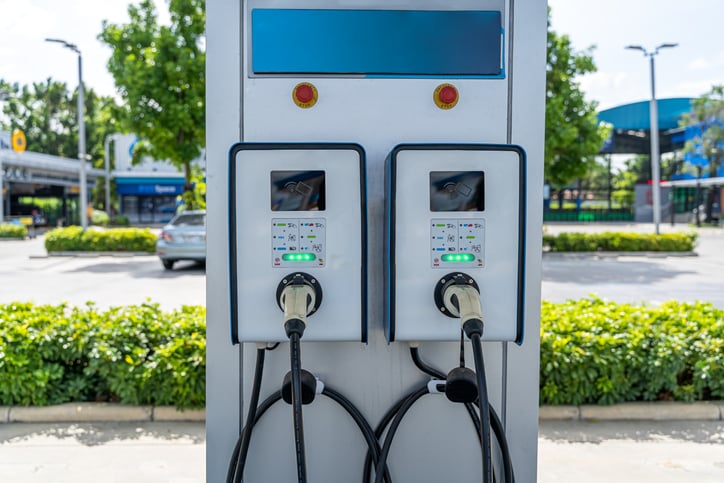EV Charging Station Safety: How Sensors Support Fast Charging

Drivers expect their vehicles to be ready when they are. For electric vehicles, that means fast, dependable charging that doesn’t compromise safety.
Fast-charging systems make EVs more practical, but they generate heat — and excess heat is a known threat to battery health. Without the right monitoring, elevated temperatures can lead to reduced performance, system shutdowns, or thermal events.
EV charging station safety depends on precise, real-time input from temperature sensors. When placed at key points throughout the vehicle and charging interface, sensors help manage thermal conditions and protect against failure. For EVs to deliver on expectations, heat can’t go unchecked — and sensors make that possible.
How EV Sensors Protect Battery Health During Fast Charging
A missing puzzle piece in the early days of electric vehicle development, new fast-charging technology is responsible in part for the ongoing electrification of transportation.
While fast-charging systems make the conversion to electric vehicles more practical, they can’t be used without proper monitoring.
This is because primary byproduct of fast charging is heat, especially when converting electrical current from AC to DC. Heat is an electric vehicle battery pack’s worst enemy and an immediate threat to EV charging station safety.
EV lithium-ion batteries of any size are designed to perform within a range of 15-45°C. Exposure to high temperatures outside of that range has harmful effects on an EV battery’s health, impacting its:
-
Ability to hold a charge: Overheating can severely hamper a battery’s ability to stay charged and extremely cold ambient temperatures can also harm batteries when charging through the formation of dendrites
-
Charging capacity: Exposure to high temperatures reduces an EV battery pack’s capacity. With less lithium present, there’s less to charge.
-
Useful life: Rechargeable batteries of any size -- from AAA to those powering an airplane -- are designed to last a few thousand charge cycles. Damage from excessive heat can reduce a battery’s usefulness by several years.
-
Safety: Overheated EV battery cells begin to decompose, triggering thermal runaway -- a chain reaction that may start a fire.
3 Critical EV Sensor Locations for Monitoring Fast Charging
High-speed EV charging can only be safe and efficient with the right sensor technology. Fast charging requires fast-response sensors – primarily vehicle temperature sensors.
Without real-time monitoring to maintain ideal temperatures, the risk of heat damage to EV components increases significantly.
There are three places in an electric vehicle where temperature sensors are a must for fast charging:
-
Charge handle Connection point
-
Thermal management system
-
Inside the battery pack
1. The Point of Connection
Temperature sensors are a must in two places at the point of connection: the charging port and the charging handle.
To charge quickly, many electrons need to pass from the EV service equipment to the vehicle battery quickly. This high current generates heat. High temperatures within the charging port may indicate there’s a poor connection between the charging handle and the EV’s contacts. From an efficiency standpoint, a poor connection means the vehicle isn’t charging as quickly as it should be. In addition, high temperatures from an EV quick charger’s connector are also a sign the charger is overtaxed by the power demand, or that it’s starting to malfunction.
2. The Thermal Management System
Overheating within an EV’s thermal management system is an immediate signal that it’s not working as intended and its components are running hot, such as:
- Heat exchangers
- Cooling plates
- Coolant fluids
- Refrigerants
- Dielectric oils
Excessive temperatures are also a sign that the EV cooling system is being overwhelmed by excessive heat from the parts they’re supposed to be cooling.
3. Inside the Battery Pack
Arguably the worst place for overheating, an EV’s battery pack must be kept within the range of 15-45°C to preserve its integrity and safety. Lithium-ion cells charge well when they are between 45 and 60C, but can suffer damage slightly above those temperatures when charging. When in-pack temperatures go beyond that range, the vehicle may go into safe mode and shut down, or worse, start the process of battery thermal event.
A battery overheating is one of the last indicators that something isn’t right with the vehicle’s charging or thermal management systems, or the battery itself is malfunctioning.
To maintain the battery’s long-term functionality and safety, immediate cooling is a necessity.
Dig into the Other sensors that are a Must for Electric vehicles
Visit our EV/HEV Resource Hub:
What’s Next for EV Fast Charging and Sensor Integration
Fast-charging technology development is far from finished.
With existing fast-charging technology, it takes around 30 minutes to re-energize an EV's battery to 80%. However, engineers are still working to make fully charging an EV as fast as filling up an ICE vehicle’s empty gas tank – a process that typically takes less than 10 minutes.
The demands for ultra-fast electric vehicle charging aren’t entirely being driven by the desire for convenience. Ground transit companies and fleet operators are pushing for ultra-fast charging that gets vehicles moving again in minutes.
Larger vehicles carry much bigger battery packs than passenger EVs, which means longer charging times – and more lost productivity.
Fast-response sensors that monitor heat throughout an EV are critical to:
-
Putting vehicles back in service faster
-
Preventing battery degradation or damage
-
Maintaining consistent charging performance in extreme conditions
EV Charging Station Safety: Common Questions About Sensor Technology
Curious how sensor technology actually supports EV charging station safety? These quick answers explain what matters most during fast charging. Q: What challenges come with placing sensors in EV fast-charging systems?A: Sensors in EVs have to work in tight, hot spaces where a lot is happening. At charging ports and inside battery packs, they’re exposed to high electrical currents and rising temperatures. That makes accurate monitoring more difficult. They also need to hold up over time. Some sensors face moisture, vibration, and wear during repeated charging. Engineers have to find spots where the sensors are protected but still effective – and not hard to install or maintain. Q: How do EVs actively respond when sensors detect overheating?A: If the system senses heat rising too fast, it usually kicks on the cooling system first. That might mean fans, coolant, or other thermal controls start working harder. If that doesn’t help, the vehicle may slow down charging or stop it completely. In some cases, the EV might enter a safe mode to protect the battery. The driver is usually alerted through the dashboard or a mobile app. Q: What are the implications of sensor failure in EV fast-charging systems?A: If a temperature sensor fails, the system might miss signs of overheating. That could damage the battery or cause a safety issue during charging. To avoid this, some EVs use backup sensors or software checks to catch bad data. If something seems off, charging might pause or switch to a slower speed. But without these safeguards, a sensor failure can be a real risk. |
Why EV Fast Charging Depends on the Right Sensors
Expectations for electric vehicles are high, especially in reliability and uptime. Fast-charging technology helps meet those demands, but only when supported by accurate thermal monitoring.
EV charging station safety relies on sensors that detect temperature changes before causing damage or failure. With the right sensor technology, charging remains efficient and safe across all vehicle types.
Integrate the Right Sensors for Fast Charging in Your EV Design
Speak with one of our engineers about the EV sensors we offer today.
This article was originally published in May of 2023 and was recently updated to reflect current industry trends.





